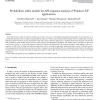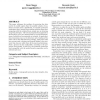33 search results - page 2 / 7 » N-Gram-Based Detection of New Malicious Code |
PR
2008
14 years 11 months ago
2008
Given the pervasive nature of malicious mobile code (viruses, worms, etc.), developing statistical/structural models of code execution is of considerable importance. We investigat...
DIMVA
2006
15 years 10 days ago
2006
Next generation malware will by be characterized by the intense use of polymorphic and metamorphic techniques aimed at circumventing the current malware detectors, based on pattern...
113
click to vote
TACAS
2012
Springer
13 years 6 months ago
2012
Springer
The number of malware is growing extraordinarily fast. Therefore, it is important to have efficient malware detectors. Malware writers try to obfuscate their code by different tec...
103
click to vote
ACSAC
2010
IEEE
14 years 7 months ago
2010
IEEE
Heap spraying is an attack technique commonly used in hijacking browsers to download and execute malicious code. In this attack, attackers first fill a large portion of the victim...
ATAL
2003
Springer
15 years 2 months ago
2003
Springer
This paper addresses the problem of protecting the data carried by mobile agents from the possible attacks of malicious execution hosts. Specifically, we consider protection mecha...


